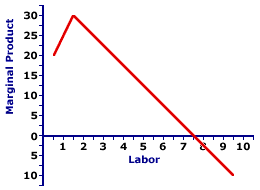
|
|
DEMAND ELASTICITY AND TOTAL EXPENDITURE: The notion that price-induced changes in total expenditure for a good (price times quantity) depends on the relative price elasticity of demand. In particular, for relatively elastic demand (1 < E < ∞) changes in price cause total expenditure to change in the opposite direction. An increase in price causes total expenditure to fall and a decrease in price causes total expenditure to rise. For relatively inelastic demand (0 < E < 1) changes in price cause total expenditure to change in the same direction. An increase in price causes total expenditure to rise and a decrease in price causes total expenditure to fall. For unit elastic demand (E =1) price changes do not cause any change in total expenditure. Total expenditure is the same whether price increases or decreases.
Visit the GLOSS*arama
|
|


|

|
                           MARGINAL PRODUCT CURVE: A curve that graphically illustrates the relation between marginal product and the quantity of the variable input, holding all other inputs fixed. This curve indicates the incremental change in output at each level of a variable input. The marginal product curve is one of three related curves used in the analysis of the short-run production of a firm. The other two are total product curve and average product curve. The marginal product curve plays in key role in the economic analysis of short-run production by a firm. The marginal product curve illustrates how marginal product is related to a variable input. While the standard analysis of short-run production relates marginal product to labor, a marginal product curve can be constructed for any variable input. | Marginal Product Curve |  |
The diagram to the right graphically represents the relation between marginal product and the variable input. This particular curve is derived from the hourly production of Super Deluxe TexMex Gargantuan Tacos (with sour cream and jalapeno peppers) as Waldo's TexMex Taco World restaurant employs additional workers. The number of workers, measured on the horizontal axis, ranges from 0 to 10 and the marginal Gargantuan Taco production of each extra worker, measured on the vertical axis, ranges from 0 to 30.The shape of this marginal product curve is worth noting. For the first two workers of variable input, marginal product increases, as each added worker contributes more to the total production of Gargantuan Tacos than previous workers. This increasing marginal product is reflected in a positive slope of the marginal product curve. Beyond the third worker, the marginal product declines, as each added worker contributes less to the total production of Gargantuan Tacos than the previous worker. This decreasing marginal product is seen as a negative slope. The marginal product eventually declines until it reaches zero and even becomes negative. This results as the marginal product curve cuts through the horizontal axis. The hump-shape of the marginal product curve embodies the essence of the analysis of short-run production. The upward-sloping portion of the marginal product curve, up to the third worker, is due to increasing marginal returns. Decreasing marginal returns sets in after the marginal product curve peaks with the second worker and declines for the third worker. In particular, this declining segment of the marginal product curve reflects the law of diminishing marginal returns.

Recommended Citation:MARGINAL PRODUCT CURVE, AmosWEB Encyclonomic WEB*pedia, http://www.AmosWEB.com, AmosWEB LLC, 2000-2025. [Accessed: July 18, 2025].
Check Out These Related Terms... | | | | | | | | | |
Or For A Little Background... | | | | | | | | | | | | | |
And For Further Study... | | | | | | | | | | |
Search Again?
Back to the WEB*pedia
|



|

|
PINK FADFLY
[What's This?]
Today, you are likely to spend a great deal of time calling an endless list of 800 numbers wanting to buy either a weathervane with a cow on top or a box of multi-colored, plastic paper clips. Be on the lookout for high interest rates.
Your Complete Scope
This isn't me! What am I?
|

|
|
A lump of pure gold the size of a matchbox can be flattened into a sheet the size of a tennis court!
|

|
|
"A winner is someone who recognizes his God-given talents, works his tail off to develop them into skills, and uses those skills to accomplish his goals. " -- Larry Bird, basketball player
|

|
BA
Bank Acceptance
|

|
|
Tell us what you think about AmosWEB. Like what you see? Have suggestions for improvements? Let us know. Click the User Feedback link.
User Feedback
|


|


